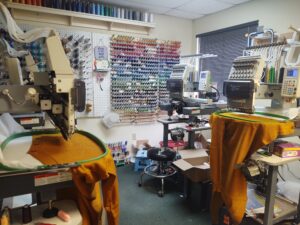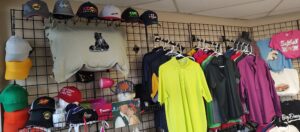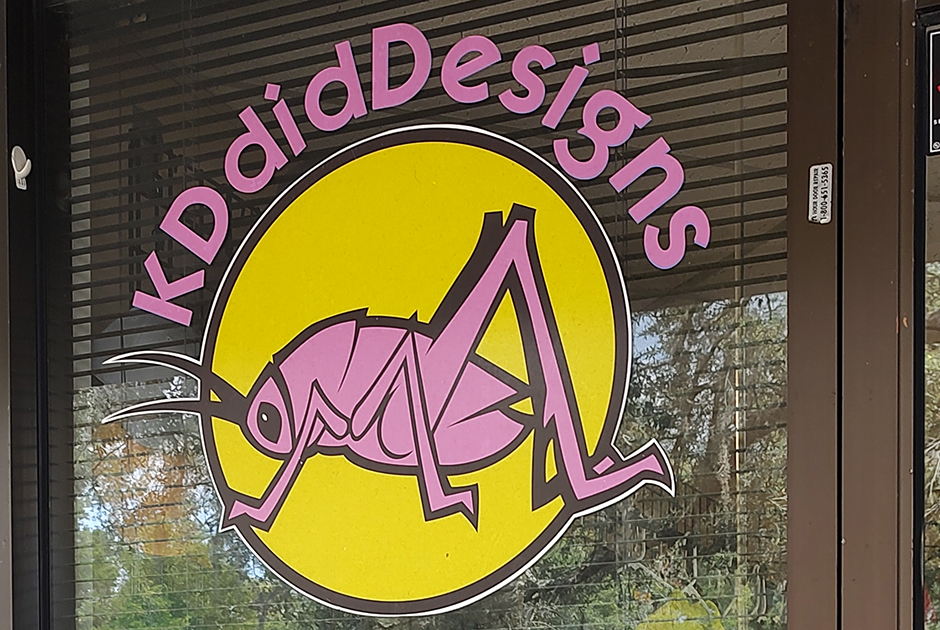Have you ever noticed that no one has ever said, “I want to be an embroidery and screen-printing business owner,” as their first career option when they finish school? I have yet to meet anyone in this industry (who is not a legitimate second- or third-generation embroidery professional) that started their first business right out of school.
Like most other business owners, Krissi Dane of KDdid Designs, LLC, joined this industry after working in a completely unrelated field. Dane was a preschool teacher who moonlighted as an artist, painting scenes on the school windows. Her creative artwork caught the attention of a local business owner who happened to own a screen print and embroidery operation. They invited Dane to visit their business, as they felt that her style of artwork would lend itself well to apparel decoration. They hired Dane a month later to become their digitizer, and the rest, as they say, is history.
Getting Started

The KDdid storefront is a hard-earned accomplishment. Photo courtesy of KDdid Designs, LLC
The first and only thing Dane was allowed to do as their newest employee was to watch the machines run, observe how the layers were sewn and pay attention to the sequence of how the designs were built. Dane began to understand how the layers of a design mesh together and how the layering of design elements influenced the results. She believes every new digitizer would benefit by observing well-digitized designs running, so they can incorporate good design theory into their own future designs.
“It was boring as heck at first,” says Dane, “But what you’re learning is so foundational to creating quality digitizing. You’re seeing pathing, you’re seeing layers.” She believes that this initial investment of time was pivotal to her developing high-quality digitizing skills.
Dane explains that many people can not see artwork in layers, they only see the two-dimensional flat image. “When you create a design for embroidery or screen printing,” she says, “You have to be able to visualize the design as a three-dimensional process and figure out what layers need to go down first in order to build a good-looking design. Otherwise, the embroidered or printed image will look flat, lifeless.”
To make it possible to work while raising three boys, Dane opened her own embroidery business, KDdid Designs, LLC, and operated it out of her home for 10 years. Her home-based embroidery business gave her the income, flexibility and stability to to support her family as a single parent.
Eventually, the business moved to a 2,000-square-foot retail location fit for production along with an expansive showroom space. As the operation grew, Dane added more equipment, including five single-head embroidery machines, a six-station screen-printing machine, a heat press, cap press and more. Dane’s team of five keep production moving, with annual sales between $150-$250k. She describes her staff as “the most amazing team anyone could ever imagine.” She says she greatly appreciates how well they work together and care about the work as much as she does. She says they are even pickier about quality control than she is at times.
“I think that is what our business is all about, adding that personal touch to every order,” Dane says. “We want to wow the customer. We don’t want them to go, ‘Oh, it’s nice.’ You know that is not a good reaction when they open the box. We want to hear, ‘Oh my gosh—It’s amazing, I love it!’” That’s what inspires Dane to stay in this industry.
“I like that my staff can take something from the beginning and go all the way through to handing the job for that customer and seeing them go ‘Wow!’ We get that sense of accomplishment.”
Marketing Your Niche
Dane is an avid fisherperson and shared that passion with her boys. She continued her involvement in the fishing industry even after she started her embroidery business by fulfilling the embroidery needs of the boat captains she knew and the fishing tournaments she competed in. Another market she’s found success with is the construction and skilled trades industries. The latter proved essential during the pandemic, as her HVAC, plumbing, catastrophic recovery and construction customers continued to place orders, helping her business survive while many other apparel-decoration businesses closed.
Being “half-crazy” is one of the mindsets required to operate a successful embroidery and apparel decoration business, according to Dane. “I think you must have a good sense of humor because you’ve got to be able to laugh at your mistakes. There are a lot of them when you first start out, even as a machine operator. As an owner, if you can’t laugh at yourself, you’re not going to last very long.”
She continues, “Having a good imagination helps as well. Sometimes the general idea that you learned at the beginning of how you run your company or how you do this specific design doesn’t always work. You must be able to come up with a new or different way to approach the situation. You need ingenuity to figure out how to accomplish it this time.”
Dane learned early on to ask questions and seek advice from other people when she faces a new challenge. She supports her staff by letting them figure out how to do jobs in the way that works best for them.
“I used to be right on top of them,” she says. “Then I figured out that if what I’m making them do doesn’t make their job more efficient and easier, then I’m kind of missing the point. The way that my embroidery manager hoops things is completely different than the way I would do it, but it works for her. She does an amazing job. I look at one of my trimmers and think, ‘How do you hold the scissors like that?’ But she does a good job, so it doesn’t really matter how she holds them, does it?”
Two of the best sellers for KDdid Designs are ball caps and letter sweaters. She jokes that she wishes she owned stock in Richardson hats, she’s decorated so many of them over the years. The letter sweaters are popular in the South, and they do hundreds and hundreds of them for several colleges in Mississippi.
Longevity Meets Loyalty
Many of Dane’s customers have been with her for years. She credits her staff for creating top-quality work and the fact that she builds relationships
with her customers as the reasons why they keep coming back. “If you form the right relationships with the right people,” Dane explains, “You’ve always got somebody you can count on. You can tell them, ‘We’re a bit slow right now. Is there anything we can do for you? We can get it back to you quickly.’ The people who we’ve built relationships with really appreciate that. Or you see a kid that you did their lunchbox for them in kindergarten and now you’re doing a graduation gift for them. That is truly something.”

Dane and team take pride in their showroom displays. Photo courtesy of KDdid Designs, LLC
Another thing that Dane says she enjoys about owning her business is the fact that no two days are ever the same.
“I might be done if it ever stops being fun,” she says, “I’m still enjoying it. There is always something new. And I have the best staff in the world. They are KDdid Designs just as much as I am. How much they care about their work has a lot to do with the quality that we turn out, they really care.”
Dane also really loves walking her customers through the workroom. “They always say, ‘Wow, I did not realize that you did all this right here!’” she chuckles, though she says she and her staff do not appreciate the frequent comments receive about how all they do is “push a button.”
Word of mouth has consistently been KDdid Designs’ most effective marketing strategy. They encourage customers to take business cards, and when asked about their decorated apparel and products to let people know where they got them. They also directly ask for their customers to post a Google review. Finally, Dane invites customers to send her photos of their events and/or staff wearing their new products. Dane then posts these images, with permission, of course, on social media and the company website.
Offering Wisdom
Dane’s most important advice for other apparel decoration professionals is this, “Don’t be a bottom feeder!” She emphasizes that if you start out as a bottom feeder, it is hard to break out of that mold. Speaking from personal experience, she says used to meet or beat competitors’ prices. But she soon realized she was going to end up having to get another job to pay for what she was doing if she kept pricing her work that way.
The other advice she offers is to develop your business plan. “I know that sounds so textbook, but making a business plan is big,” Dane says. “Because then you know who your audience is, you know who you should go after, you know who you can go to find a support group if you’re not near your family or friends who are business owners.”
Looking to the future, five or 10 years from now, Dane says she would like to own a building. “The goal when you build a business is to build it so that eventually, you can sell it. I want to sell the entire package, the business, the building, and everything that comes with it.”
As the founder of the National Network of Embroidery Professionals (NNEP), Jennifer Cox has worked with thousands of embroidery and decorated-apparel business owners to help them build successful businesses for over the past 25 years. NNEP supports members with services, savings and programs designed to help its members find customers, keep customers and make money. To find out more, or share any of the challenges your own company may currently be experiencing, go to NNEP.com.





